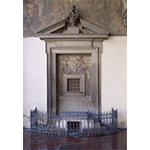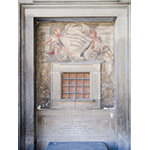Istituto degli Innocenti - Ospedale degli Innocenti [Institute and Hospital "degli Innocenti"]
The Institute was founded in 1419 by the Silk Merchants Guild as a home for abandoned children. The project was commissioned of Filippo Brunelleschi, who designed one of the most important building complexes of Renaissance architecture. Since 1445, when the Institute was officially inaugurated and the first baby was left there, it has never ceased its activity, adapting it to the changing times. At first, abandoned babies were left in a kind of holy-water basin, which stood on the right side of the loggia. In the second half of the 17th century the basin was replaced by a "wheel", a revolving stone placed at the opposite end of the loggia, which remained in service up to the second half of the 19th century. The children, first cared for by wet-nurses outside of the Institute, were then assigned to families in the province (for the most part farmers) who were paid to raise them. Physical and moral protection of the "gettatelli" (literally, "thrown away" children) was provided up to the age of 18 for the boys, while the girls were offered hospitality until they married, at which time they were given the necessary dowry. In 1815, at the order of Ferdinand III there was instituted, on premises adjacent to the Hospital, a Maternity Hospice, to which was assigned a Chair for the professional training of midwives. The teaching of obstetrics, already active at the School of Obstetrics, was thus divided into Theoretical Obstetrics (at the Hospital of Santa Maria Nuova) and Practical Obstetrics (at the Hospital "degli Innocenti").
The Institute, possessing a laboratory that produced vaccines for all of Tuscany, was also important for its work in spreading the practice of vaccination, starting from the late 18th century and recognised by the Grand Duke in the 1830s. Today it is a public institution with a board of directors, whose Chairman is elected by the Region of Tuscany. It has a collection of around sixty medical and laboratory instruments from the 19th and 20th centuries.
The importance of this institution in the fields of the history of medicine and of art is borne witness to by its archives by the works conserved in the Hospital Museum, which occupies the hall above Brunelleschi’s loggia.
Today the Institute, in addition to continuing its tradition as centre of assistance for children, adolescents and the family, is also a centre of documentation, research, analysis and training.
****************************
Texts by Antonella Gozzoli
English translation by Catherine Frost
Last update 22/apr/2008





